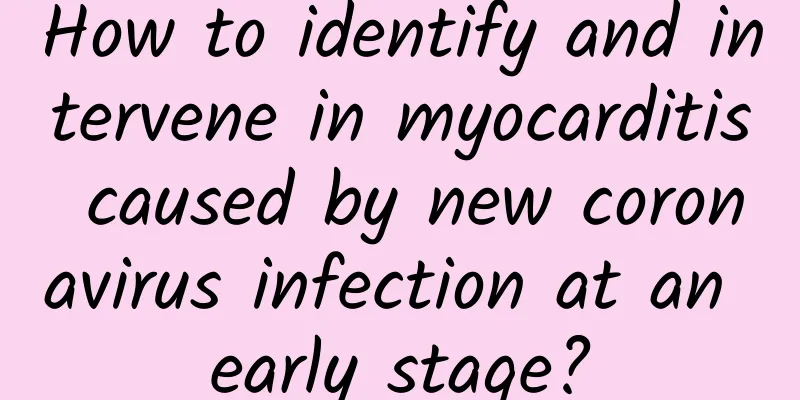How to identify and intervene in myocarditis caused by new coronavirus infection at an early stage?

|
Recently, many news reports have revealed cases of myocarditis and even sudden death caused by COVID-19 infection, which has put the disease of "myocarditis" at the forefront. In addition to respiratory departments, the number of patients in cardiovascular departments in hospitals across the country has also remained high. Based on this, this article will combine the expert consensus on myocarditis in recent years and relevant domestic and foreign literature to discuss in detail how clinical practice can identify and intervene in COVID-19-related myocarditis early to minimize the risk of death in patients. 1. Infection Mechanism Myocarditis, as the name suggests, is an inflammatory disease that occurs in the myocardium. Most people believe that myocarditis is caused by the direct infection of the myocardium by the new coronavirus, but this is not the case. In June 2022, an expert consensus on cardiovascular diseases related to the new coronavirus (hereinafter referred to as the consensus) published in JACC mentioned that although the new coronavirus RNA can be detected in the myocardium of 25% to 50% of patients with new coronary pneumonia, most of the new coronavirus exists in inflammatory cells, not myocardial cells. In other words, most COVID-19-related myocarditis is not caused by the direct invasion of myocardial cells by the new coronavirus, but rather by the body producing a large number of cells to resist the virus, which "accidentally injure" myocardial cells in the process of eliminating the virus (excessive immune response). As for the cases of sudden death due to myocarditis reported in the news, most of them are fulminant myocarditis , a disease characterized by severe edema and dysfunction of myocardial tissue, with rapid onset, severe condition, rapid progression and poor prognosis , with a mortality rate as high as 80% . 2. Diagnosis 1. Symptoms and related examinations Most myocarditis symptoms are similar to those of a cold in the early stages of the disease, such as runny nose, fever, general fatigue, muscle aches, etc. As the disease progresses, some patients will experience typical symptoms of myocarditis, such as chest tightness, chest pain, and dyspnea . Clinicians should be highly sensitive and vigilant and conduct a comprehensive examination of suspected patients (Table 1). Table 1 Common myocarditis examinations and changes 2. Diagnostic criteria There is currently no unified diagnostic standard for "COVID-19 infection-related myocarditis". At this stage, it is mainly diagnosed clinically, based on a typical history of prodromal infection (COVID-19 infection, nucleic acid positive), typical clinical manifestations and signs, and confirmed by endomyocardial biopsy, or elevated troponin + imaging evidence of myocardial damage. However, the symptoms of COVID-19 infection and myocarditis are highly similar, which increases the difficulty of diagnosing the disease. In addition, endomyocardial biopsy is an invasive examination and not all hospitals can perform it. At the same time, from the perspective of public acceptance, mobilizing people to sign informed consent will also take a long time, which is not conducive to clinical diagnosis and treatment. Based on this, the consensus suggests that patients need to complete basic examinations such as electrocardiogram, echocardiogram, and troponin , and those with abnormal test results should further undergo cardiac magnetic resonance imaging . Those with abnormal results should be highly alert to COVID-19-related myocarditis and are advised to receive hospitalization. Treatment There is no specific treatment for this disease in clinical practice. The "Chinese Expert Consensus on Diagnosis and Treatment of Fulminant Myocarditis in Adults" (Chinese Solution) proposes that the treatment approach for this disease is mainly "a comprehensive treatment plan based on life support." 1. General treatment Patients need to stay in bed and avoid emotional excitement; patients with fever should be cooled to improve myocardial energy metabolism. 2. Anti-COVID-19 treatment Depending on the patient's condition, anti-new coronavirus drugs such as Azvudine and Paxiovid may be used as appropriate. 3. Immunomodulatory therapy (1) Glucocorticoids The Chinese approach uses hormone therapy as a key rescue measure. If the patient is highly suspected of having a tendency to fulminant myocarditis, 1 g of succinimidyl sulfate can be immediately given intravenously for 1 to 4 days to suppress the immune response and correct the immune disorder. (2) Immunoglobulin Immunoglobulins can inhibit the excessive activation of inflammatory cells, thereby significantly inhibiting excessive inflammatory responses, playing an important role in immune regulation and improving heart function. 4. Supportive treatment The aortic balloon counterpulsation is used to reduce the cardiac afterload and relieve the burden on the heart; extracorporeal membrane oxygenation participates in systemic circulation perfusion to allow the heart to get sufficient rest; non-invasive ventilator-assisted ventilation is used, and endotracheal intubation or invasive mechanical ventilation is performed when necessary. Myocarditis associated with COVID-19 infection should not be underestimated. Suspected patients should be examined in detail during clinical consultation to buy more treatment time for the patients and avoid missing the best treatment opportunity. In terms of treatment, the Chinese plan should be followed and reasonable treatment should be given in combination with the patient's condition to maximize the improvement of prognosis. References [1] Writing Committee, Gluckman TJ, Bhave NM, et al. 2022 ACC expert consensus decision pathway on cardiovascular sequelae of COVID-19 in adults: myocarditis and other myocardial involvement, post-acute sequelae of SARS-CoV-2 infection, and return to play: a report of the American College of cardiology solution set oversight Committee[J].JACC, 2022, 79(17): 1717-1756. [2] Kornowski R, Witberg G. Acute myocarditis caused by COVID-19 disease and following COVID-19 vaccination[J]. Open Heart, 2022, 9(1):e001957. [3] Wang Daowen, Hui Rutai. Chinese expert consensus on the diagnosis and treatment of fulminant myocarditis in adults[J]. Chinese Journal of Cardiovascular Diseases, 2022, 50(3): 212-218. [4]Siripanthong B, Nazarian S, Muser D, et al.Recognizing COVID-19–related myocarditis: The possible pathophysiology and proposed guideline for diagnosis and management[J].Heart rhythm, 2020, 17(9):1463-1471. |
>>: Can we still eat oranges washed with “fresh water”? Expert interpretation →
Recommend
How to prepare for pregnancy with cervicitis
Many cases of cervicitis occur in women. This dis...
How long should I wait to breastfeed after eating ice cream during breastfeeding?
Ice cream is a refrigerated dessert that clears a...
What is the cause of the pain in the lower abdomen?
Many people are very concerned about their physic...
Can I still stimulate milk production after my milk has stopped flowing?
For a newborn baby, new parents want to give him ...
To deal with SLE, you must make good use of "strategies" and "military tactics" to attack it, only then can you win
There are thousands of lupus problems. Finding th...
2 months pregnant belly like 4 months
We all know that the baby first lives in the moth...
What causes left shoulder pain in women?
In recent years, people's work and rest time ...
Is it normal to delay my period by two days?
Working women are very busy at work. In addition ...
Is it difficult to treat fallopian tube adhesions?
Some women suffer from fallopian tube adhesions, ...
Why do girls always want to have sex?
In real life, "pa" refers to sexual lif...
How to relieve the pain when your period comes?
Nowadays, people pay more and more attention to t...
Do you have a sensitive nose in the fall? Let’s take a look at the climate diseases that occur during the season change!
Right now, as the summer and autumn seasons chang...
What is the best age for women to stop menstruating?
When it comes to menopause, almost all women agre...
Why amenorrhea?
Amenorrhea is a situation that every woman will e...
Pay attention to 5 kinds of mouth diseases
1. Red and swollen gums This is a typical symptom...









